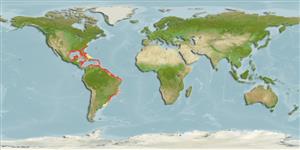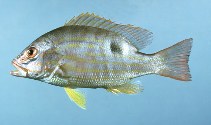Добавить Ваши наблюдения в Fish Watcher
| Native range | All suitable habitat | Point map | Year 2050 |

|
| This map was computer-generated and has not yet been reviewed. |
| Lutjanus synagris AquaMaps Data sources: GBIF OBIS |
Cuba country information
Common names:
Biajaiba, Lane Snapper, Manchego
Occurrence: native
Salinity: marine
Abundance: abundant (always seen in some numbers) | Ref: Claro, R., 1994
Importance: commercial | Ref: Claro, R., 1994
Aquaculture: | Ref:
Regulations: | Ref:
Uses: no uses
Comments: Catches greater than 500 tons/year. Also Ref. 26340.
National Checklist:
Country Information: https://www.cia.gov/library/publications/resources/the-world-factbook/geos/cu.html
National Fisheries Authority:
Occurrences: Occurrences Point map
Main Ref: Claro, R. and L.R. Parenti, 2001
National Database:
Occurrence: native
Salinity: marine
Abundance: abundant (always seen in some numbers) | Ref: Claro, R., 1994
Importance: commercial | Ref: Claro, R., 1994
Aquaculture: | Ref:
Regulations: | Ref:
Uses: no uses
Comments: Catches greater than 500 tons/year. Also Ref. 26340.
National Checklist:
Country Information: https://www.cia.gov/library/publications/resources/the-world-factbook/geos/cu.html
National Fisheries Authority:
Occurrences: Occurrences Point map
Main Ref: Claro, R. and L.R. Parenti, 2001
National Database:
Common names from other countries
Классификация / Names народные названия | синонимы | Catalog of Fishes(род, виды) | ITIS | CoL | WoRMS | Cloffa
> Eupercaria/misc (Various families in series Eupercaria) > Lutjanidae (Snappers) > Lutjaninae
Etymology: Lutjanus: Malay, ikan lutjan, name of a fish.
More on author: Linnaeus.
Etymology: Lutjanus: Malay, ikan lutjan, name of a fish.
More on author: Linnaeus.
Environment: milieu / climate zone / depth range / distribution range экология
морской ассоциированный с рифами; пределы глубины 10 - 400 m (Ref. 9626), usually 21 - 70 m (Ref. 9626). Subtropical; 38°N - 38°S, 98°W - 31°W (Ref. 55253)
распространение страны | регионы FAO | Ecosystems | места находок | Point map | интродукции | Faunafri
Western Atlantic: Bermuda (Anderson, pers. comm.) and North Carolina, USA to southeastern Brazil, including Gulf of Mexico and Caribbean Sea (Ref. 9626). Most abundant around the Antilles, on the Campeche Bank, off Panama and the northern coast of South America. Lutjanus ambiguus (Poey, 1860), an intergeneric hybrid with Ocyurus chrysurus (Bloch) as demonstrated by Loftus (1992: Ref. 33006), followed by McEachran &. Fechhelm (2005: Ref. 78464).
Length at first maturity / Size / Вес / Возраст
Maturity: Lm 23.4, range 16 - 21.5 cm
Max length : 60.0 cm TL самец/пол неопределен; (Ref. 40637); common length : 25.0 cm TL самец/пол неопределен; (Ref. 55); наибольший вес (опубликованные данные): 3.5 kg (Ref. 40637); наибольший возраст (опубликованны данные): 10 годы (Ref. 3090)
Max length : 60.0 cm TL самец/пол неопределен; (Ref. 40637); common length : 25.0 cm TL самец/пол неопределен; (Ref. 55); наибольший вес (опубликованные данные): 3.5 kg (Ref. 40637); наибольший возраст (опубликованны данные): 10 годы (Ref. 3090)
Краткое описание определительные ключи | морфология | морфометрия
колючие лучи спинного плавника (общее число) : 10; членистые (мягкие) лучи спинного плавника (общее число) : 12 - 13; колючие лучи анального плавника: 3; членистые (мягкие) лучи анального плавника: 8 - 9. Preopercular notch and knob weak. Pectoral fins short, not reaching level of anus. Scale rows on back rising obliquely above lateral line. Back and upper side pink to reddish, with a green tinge and diffused darker vertical bars. The lower sides and belly silvery with a yellow tinge. A series of 8 - 10 horizontal yellow or golden stripes on sides. A diffused black spot mainly above the lateral line and below the anterior portion of the soft dorsal-fin rays.
Adults are found over all types of bottom, but mainly around coral reefs and on vegetated sandy areas. In turbid as well as clear water (Ref. 9710). They often form large aggregations, especially during the breeding season. Feed at night on small fishes, bottom-living crabs, shrimps, worms, gastropods and cephalopods. Good food fish, it is marketed fresh.
Life cycle and mating behavior половая зрелость | размножение | нерест | икра | Fecundity | личинки
Often form large aggregations, especially during the breeding season.
Основная ссылка
Upload your references | ссылки | координатор | соавторы
Allen, G.R., 1985. FAO Species Catalogue. Vol. 6. Snappers of the world. An annotated and illustrated catalogue of lutjanid species known to date. FAO Fish. Synop. 125(6):208 p. Rome: FAO. (Ref. 55)
Статус Красного Списка МСОП (Ref. 130435: Version 2024-2)
Близок к исчезновению (NT) ; Date assessed: 10 October 2015
Использование человеком
рыболовство: коммерческий; объект спортивного рыболовства: да; аквариум: общественные аквариумы
FAO(рыболовство: production; publication : search) | FishSource | Sea Around Us
дополнительная информация
Population dynamics
Growth parameters
Max. ages / sizes
Length-weight rel.
Length-length rel.
Размерный состав
Mass conversion
пополнение
численность
Growth parameters
Max. ages / sizes
Length-weight rel.
Length-length rel.
Размерный состав
Mass conversion
пополнение
численность
Life cycle
размножение
половая зрелость
Fecundity
нерест
Spawning aggregations
икра
Развитие икры
личинки
динамика численности личинок
размножение
половая зрелость
Fecundity
нерест
Spawning aggregations
икра
Развитие икры
личинки
динамика численности личинок
Anatomy
жаберная область
Brain
Otolith
жаберная область
Brain
Otolith
Physiology
Body composition
Nutrients
Oxygen consumption
Swimming type
Swimming speed
Visual pigments
Fish sound
Diseases & Parasites
Toxicity (LC50s)
Body composition
Nutrients
Oxygen consumption
Swimming type
Swimming speed
Visual pigments
Fish sound
Diseases & Parasites
Toxicity (LC50s)
Genetics
генетика
Heterozygosity
наследуемость
генетика
Heterozygosity
наследуемость
Human related
Aquaculture systems
особенности рыбоводства
степень растяжения
Ciguatera cases
Stamps, coins, misc.
Aquaculture systems
особенности рыбоводства
степень растяжения
Ciguatera cases
Stamps, coins, misc.
инструменты
E-book | полевой определитель | определительные ключи | Длина-Частота | онтогенез | карта точек | Classification Tree
| Catch-MSY |
Специальные отчеты
Проверить содержание в аквариумах | Проверить опубликованные видовые данные | Проверить опубликованные данные по аквакультуре
Скачать в формате XML
ресурсы в Интернет
Aquatic Commons | BHL | Cloffa | Websites from users | Проверить FishWatcher | CISTI | Catalog of Fishes(род, виды) | DiscoverLife | ECOTOX | Faunafri | Fishtrace | GenBank(Геном, Нуклеотид) | GloBI | GOBASE | GoMexSI (interaction data) | | Google Books | Google Scholar | Google | IGFA World Record | MitoFish | национальные базы данных | Otolith Atlas of Taiwan Fishes | общественные аквариумы | PubMed | Reef Life Survey | Определение с помощью Regulatory Fish Encyclopedia | Scirus | SeaLifeBase | Tree of Life | Wikipedia(Вперёд, поиск) | World Records Freshwater Fishing | Zoological Record
Estimates based on models
Preferred temperature (Ref. 115969): 19.7 - 27.5, mean 24.7 (based on 260 cells).
Phylogenetic diversity index (Ref. 82804): PD50 = 0.5000 [Uniqueness, from 0.5 = low to 2.0 = high].
Bayesian length-weight: a=0.01514 (0.01359 - 0.01685), b=2.96 (2.94 - 2.98), in cm Total Length, based on LWR estimates for this species (Ref. 93245).
Trophic level (Ref. 69278): 3.8 ±0.2 se; based on diet studies.
устойчивость к внешним воздействиям (Ref. 120179): средний (среднего размера), минимальное время удвоения популяции 1.4-4.4 года (K=0.13-0.26; tm=2; tmax=10).
Prior r = 0.87, 95% CL = 0.57 - 1.30, Based on 6 data-limited stock assessments.
Fishing Vulnerability (Ref. 59153): Moderate vulnerability (37 of 100).
Climate Vulnerability (Ref. 125649): High to very high vulnerability (74 of 100).





